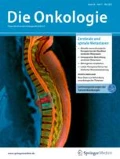Zusammenfassung
Die Anzahl von molekularen Untersuchungen in der Histo- und Zytopathologie hat in den letzten Jahren, insbesondere mit zunehmender Bedeutung der sog. personalisierten Medizin bei Krebspatienten, stark zugenommen. Die Ergebnisse dieser Untersuchungen fließen vermehrt in die Pathologieberichte ein, die den behandelnden Ärzten als Grundlage für weitere Therapieentscheidungen dienen. Die wichtigsten molekularen Methoden, die derzeit in der Pathologie eingesetzt werden, werden mit ihren Möglichkeiten und Grenzen vorgestellt.
Abstract
The number of molecular tests used in histopathology and cytopathology has increased dramatically during the last years in particular as a result of the increasing influence of so-called personalized medicine in oncology patients. The results of these tests are becoming increasingly more integrated into pathology reports and serve the treating clinicians as a basis for further therapeutic decisions. The most important molecular methods currently used in pathology are presented including the capabilities and limitations.
Literatur
Moch H, Blank PR, Dietel M et al (2012) Personalized cancer medicine and the future of pathology. Virchows Arch 460:3–8
Stricker T, Catenacci DVT, Seiwert TY (2011) Molecular profiling of cancer – the future of personalized cancer medicine: a primer on cancer biology and the tools necessary to bring molecular testing to the clinic. Semin Oncol 38:173–185
Igbokwe A, Lopez-Terrada DH (2011) Molecular testing of solid tumors. Arch Pathol Lab Med 135:67–82
Geyer CE, Forster J, Lindquist D et al (2006) Lapatinib plus capecitabine for HER2-positive advanced breast cancer. N Engl J Med 355:2733–2743
Hortobagyi GN (2005) Trastuzumab in the treatment of breast cancer. N Engl J Med 353:1734–1736
Varga Z, Diebold J, Dommann-Scherrer C et al (2012) How reliable is Ki-67 immunohistochemistry in grade 2 breast carcinomas? A QA study of the Swiss working group of breast- and gynecopathologists. PLoS One 7:e37379
Rubin BP, Heinrich MC, Corless CL (2007) Gastrointestinal stromal tumour. Lancet 369:1731–1741
Maemondo M, Inoue A, Kobayashi K et al (2010) Gefitinib or chemotherapy for non-small-cell lung cancer with mutated EGFR. N Engl J Med 362:2380–2388
Flaherty KT, Puzanov I, Kim KB et al (2010) Inhibition of mutated, activated BRAF in metastatic melanoma. N Engl J Med 363:809–819
Jimeno A, Messersmith WA, Hirsch FR et al (2009) KRAS mutations and sensitivity to epidermal growth factor receptor inhibitors in colorectal cancer: practical application of patient selection. J Clin Oncol 27:1130–1136
Anonymous (2011) Getting personal. Nature 473:253–254
Luciano JS, Andersson B, Batchelor C (2011) The translational medicine ontology and knowledge base: driving personalized medicine by bridging the gap between bench and bedside. J Biomed Semantics 2 [Suppl 2] 2:S1
Dahinden C, Ingold B, Wild P et al (2010) Mining tissue microarray data to uncover combinations of biomarker expression patterns that improve intermediate staging and grading of clear cell renal cell cancer. Clin Cancer Res 16:88–98
Jones S, Zhang X, Parsons DW et al (2008) Core signaling pathways in human pancreatic cancers revealed by global genomic analyses. Science 321:1801–1806
Carracedo A, Ma L, Teruya-Feldstein J et al (2008) Inhibition of mTORC1 leads to MAPK pathway activation through a PI3K-dependent feedback loop in human cancer. J Clin Invest 118:3065–3074
Dietel M, Sers C (2006) Personalized medicine and development of targeted therapies: the upcoming challenge for diagnostic molecular pathology. A review. Virchows Arch 448:744–755
Bundesaerztekammer (2010) (Muster-)Weiterbildungsordnung 2003 – Fassung vom 25.06.2010. Bundesaerztekammer, Berlin
Lehr HA, Moch H, Christen B et al (2012) Board examination for anatomical pathology in Switzerland: two intense days to verify professional competence. Virchows Arch 461:87–92
Interessenkonflikt
Der korrespondierende Autor gibt für sich und seinen Koautor an, dass kein Interessenkonflikt besteht.
Author information
Authors and Affiliations
Corresponding author
Rights and permissions
About this article
Cite this article
Rössle, M., Moch, H. Bedeutung molekularpathologischer Methoden in der Onkologie. Onkologe 18, 1149–1156 (2012). https://doi.org/10.1007/s00761-012-2362-3
Published:
Issue Date:
DOI: https://doi.org/10.1007/s00761-012-2362-3
Schlüsselwörter
- Molekulare Pathologie
- Immunhistochemie
- In-situ-Hybridisierung
- „Next-generation sequencing“
- Therapieentscheidung

